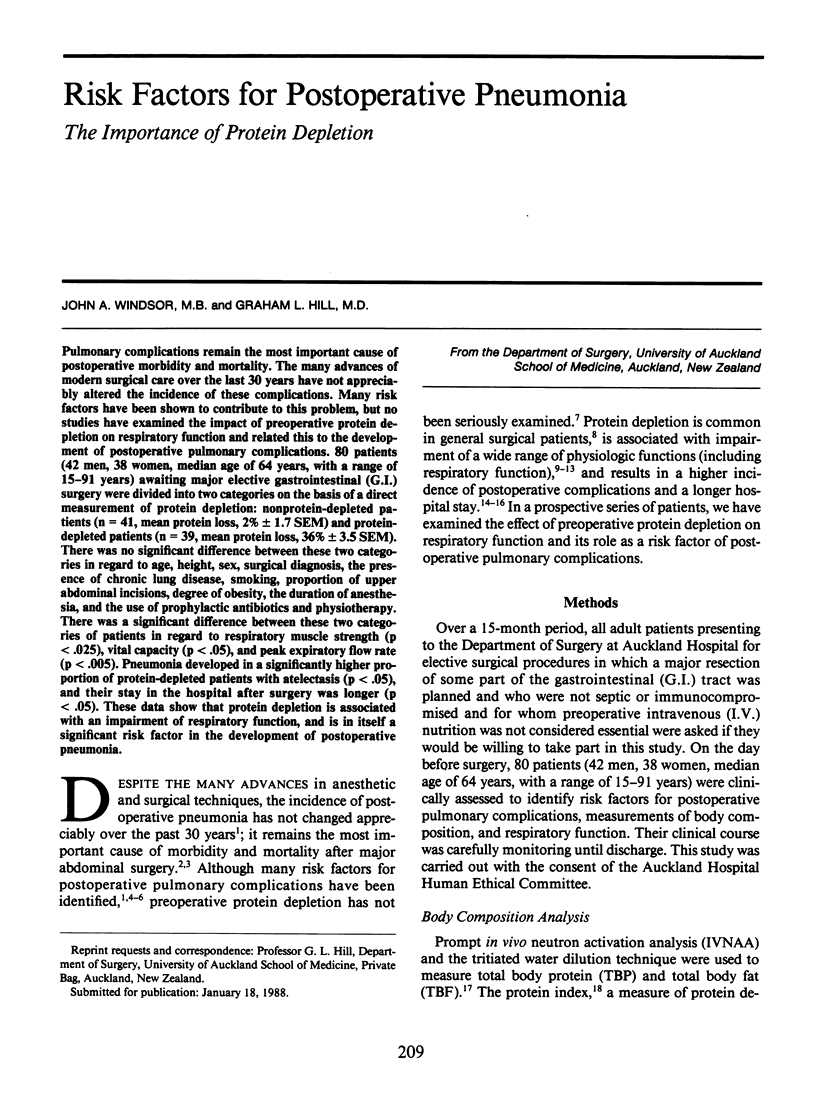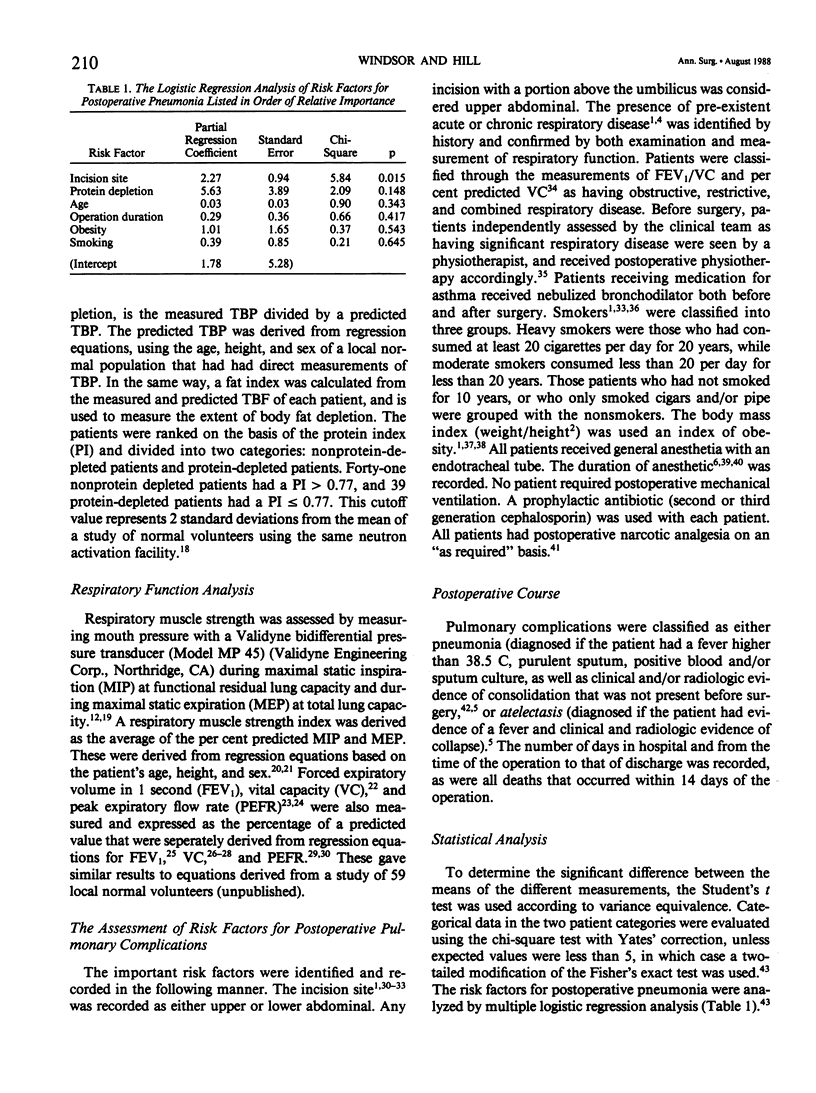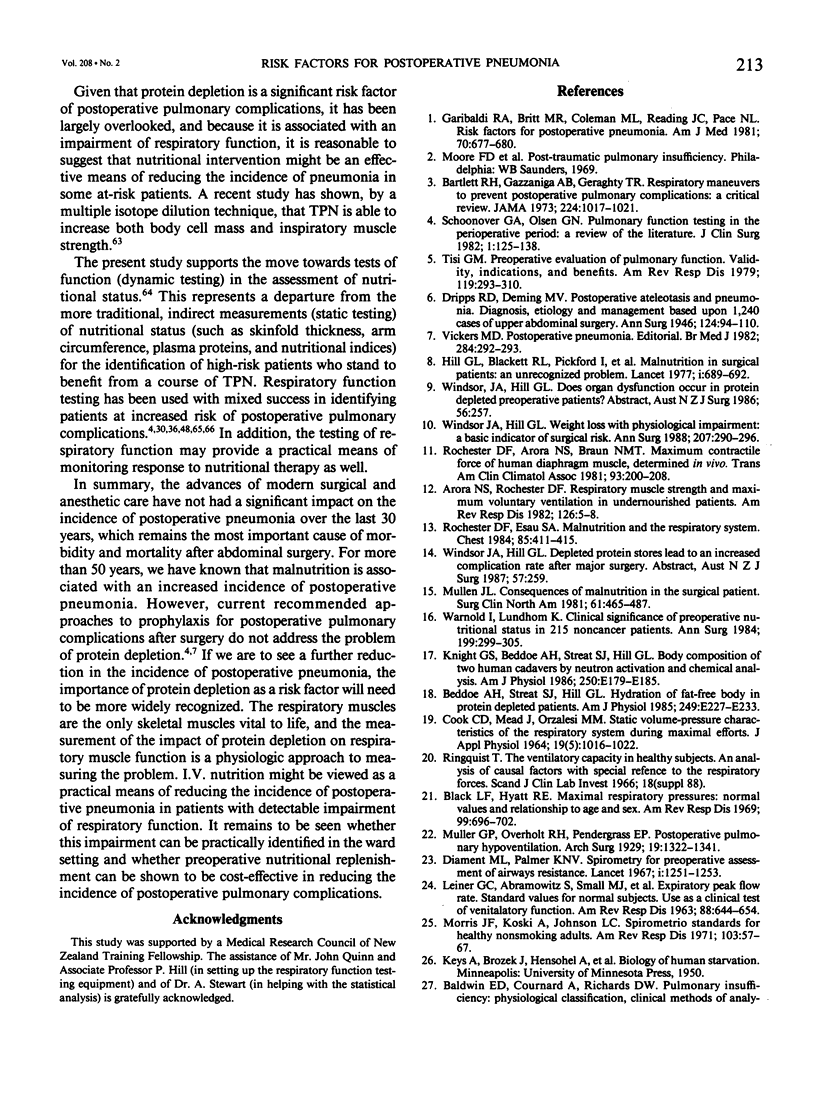Abstract
Pulmonary complications remain the most important cause of postoperative morbidity and mortality. The many advances of modern surgical care over the last 30 years have not appreciably altered the incidence of these complications. Many risk factors have been shown to contribute to this problem, but no studies have examined the impact of preoperative protein depletion on respiratory function and related this to the development of postoperative pulmonary complications. 80 patients (42 men, 38 women, median age of 64 years, with a range of 15-91 years) awaiting major elective gastrointestinal (G.I.) surgery were divided into two categories on the basis of a direct measurement of protein depletion: nonprotein-depleted patients (n = 41, mean protein loss, 2% +/- 1.7 SEM) and protein-depleted patients (n = 39, mean protein loss, 36% +/- 3.5 SEM). There was no significant difference between these two categories in regard to age, height, sex, surgical diagnosis, the presence of chronic lung disease, smoking, proportion of upper abdominal incisions, degree of obesity, the duration of anesthesia, and the use of prophylactic antibiotics and physiotherapy. There was a significant difference between these two categories of patients in regard to respiratory muscle strength (p less than .025), vital capacity (p less than .05), and peak expiratory flow rate (p less than .005). Pneumonia developed in a significantly higher proportion of protein-depleted patients with atelectasis (p less than .05), and their stay in the hospital after surgery was longer (p less than .05). These data show that protein depletion is associated with an impairment of respiratory function, and is in itself a significant risk factor in the development of postoperative pneumonia.
Full text
PDF





Selected References
These references are in PubMed. This may not be the complete list of references from this article.
- ANDERSON W. H., DOSSETT B. E., Jr, HAMILTON G. L. PREVENTION OF POSTOPERATIVE PULMONARY COMPLICATIONS. USE OF ISOPROTERENOL AND INTERMITTENT POSITIVE PRESSURE BREATHING ON INSPIRATION. JAMA. 1963 Nov 23;186:763–766. doi: 10.1001/jama.1963.03710080035007. [DOI] [PubMed] [Google Scholar]
- Alexander J. I., Parikh R. K., Spence A. A. Postoperative analgesia and lung function: a comparison of narcotic analgesic regimens. Br J Anaesth. 1973 Apr;45(4):346–352. doi: 10.1093/bja/45.4.346. [DOI] [PubMed] [Google Scholar]
- Arora N. S., Rochester D. F. Effect of body weight and muscularity on human diaphragm muscle mass, thickness, and area. J Appl Physiol Respir Environ Exerc Physiol. 1982 Jan;52(1):64–70. doi: 10.1152/jappl.1982.52.1.64. [DOI] [PubMed] [Google Scholar]
- Arora N. S., Rochester D. F. Respiratory muscle strength and maximal voluntary ventilation in undernourished patients. Am Rev Respir Dis. 1982 Jul;126(1):5–8. doi: 10.1164/arrd.1982.126.1.5. [DOI] [PubMed] [Google Scholar]
- Bartlett R. H., Gazzaniga A. B., Geraghty T. R. Respiratory maneuvers to prevent postoperative pulmonary complications. A critical review. JAMA. 1973 May 14;224(7):1017–1021. [PubMed] [Google Scholar]
- Baxter W. D., Levine R. S. An evaluation of intermittent positive pressure breathing in the prevention of postoperative pulmonary complications. Arch Surg. 1969 Jun;98(6):795–798. doi: 10.1001/archsurg.1969.01340120143027. [DOI] [PubMed] [Google Scholar]
- Beddoe A. H., Streat S. J., Hill G. L. Hydration of fat-free body in protein-depleted patients. Am J Physiol. 1985 Aug;249(2 Pt 1):E227–E233. doi: 10.1152/ajpendo.1985.249.2.E227. [DOI] [PubMed] [Google Scholar]
- Beecher H. K. EFFECT OF LAPAROTOMY ON LUNG VOLUME. DEMONSTRATION OF A NEW TYPE OF PULMONARY COLLAPSE. J Clin Invest. 1933 Jul;12(4):651–658. doi: 10.1172/JCI100526. [DOI] [PMC free article] [PubMed] [Google Scholar]
- Beecher H. K. THE MEASURED EFFECT OF LAPAROTOMY ON THE RESPIRATION. J Clin Invest. 1933 Jul;12(4):639–650. doi: 10.1172/JCI100525. [DOI] [PMC free article] [PubMed] [Google Scholar]
- Black L. F., Hyatt R. E. Maximal respiratory pressures: normal values and relationship to age and sex. Am Rev Respir Dis. 1969 May;99(5):696–702. doi: 10.1164/arrd.1969.99.5.696. [DOI] [PubMed] [Google Scholar]
- COOK C. D., MEAD J., ORZALESI M. M. STATIC VOLUME-PRESSURE CHARACTERISTICS OF THE RESPIRATORY SYSTEM DURING MAXIMAL EFFORTS. J Appl Physiol. 1964 Sep;19:1016–1022. doi: 10.1152/jappl.1964.19.5.1016. [DOI] [PubMed] [Google Scholar]
- DAVIDSON J. Prevention of postoperative chest complications. Lancet. 1953 Jun 20;1(6773):1225–1226. doi: 10.1016/s0140-6736(53)92257-0. [DOI] [PubMed] [Google Scholar]
- De Troyer A., Borenstein S., Cordier R. Analysis of lung volume restriction in patients with respiratory muscle weakness. Thorax. 1980 Aug;35(8):603–610. doi: 10.1136/thx.35.8.603. [DOI] [PMC free article] [PubMed] [Google Scholar]
- Diament M. L., Palmer K. N. Spirometry for preoperative assessment of airways resistance. Lancet. 1967 Jun 10;1(7502):1251–1253. doi: 10.1016/s0140-6736(67)92715-8. [DOI] [PubMed] [Google Scholar]
- Dripps R. D., Van N Deming M. Postoperative Atelectasis and Pneumonia: Diagnosis, Etiology and Management Based upon 1,240 Cases of upper Abdominal Surgery. Ann Surg. 1946 Jul;124(1):94–110. [PMC free article] [PubMed] [Google Scholar]
- GAENSLER E. A., CUGELL D. W., LINDGREN I., VERSTRAETEN J. M., SMITH S. S., STRIEDER J. W. The role of pulmonary insufficiency in mortality and invalidism following surgery for pulmonary tuberculosis. J Thorac Surg. 1955 Feb;29(2):163–187. [PubMed] [Google Scholar]
- Garibaldi R. A., Britt M. R., Coleman M. L., Reading J. C., Pace N. L. Risk factors for postoperative pneumonia. Am J Med. 1981 Mar;70(3):677–680. doi: 10.1016/0002-9343(81)90595-7. [DOI] [PubMed] [Google Scholar]
- Gregg I., Nunn A. J. Peak expiratory flow in normal subjects. Br Med J. 1973 Aug 4;3(5874):282–284. doi: 10.1136/bmj.3.5874.282. [DOI] [PMC free article] [PubMed] [Google Scholar]
- Hill G. L., Blackett R. L., Pickford I., Burkinshaw L., Young G. A., Warren J. V., Schorah C. J., Morgan D. B. Malnutrition in surgical patients. An unrecognised problem. Lancet. 1977 Mar 26;1(8013):689–692. doi: 10.1016/s0140-6736(77)92127-4. [DOI] [PubMed] [Google Scholar]
- Kelly S. M., Rosa A., Field S., Coughlin M., Shizgal H. M., Macklem P. T. Inspiratory muscle strength and body composition in patients receiving total parenteral nutrition therapy. Am Rev Respir Dis. 1984 Jul;130(1):33–37. doi: 10.1164/arrd.1984.130.1.33. [DOI] [PubMed] [Google Scholar]
- Knight G. S., Beddoe A. H., Streat S. J., Hill G. L. Body composition of two human cadavers by neutron activation and chemical analysis. Am J Physiol. 1986 Feb;250(2 Pt 1):E179–E185. doi: 10.1152/ajpendo.1986.250.2.E179. [DOI] [PubMed] [Google Scholar]
- LEINER G. C., ABRAMOWITZ S., SMALL M. J., STENBY V. B., LEWIS W. A. EXPIRATORY PEAK FLOW RATE. STANDARD VALUES FOR NORMAL SUBJECTS. USE AS A CLINICAL TEST OF VENTILATORY FUNCTION. Am Rev Respir Dis. 1963 Nov;88:644–651. doi: 10.1164/arrd.1963.88.5.644. [DOI] [PubMed] [Google Scholar]
- Latimer R. G., Dickman M., Day W. C., Gunn M. L., Schmidt C. D. Ventilatory patterns and pulmonary complications after upper abdominal surgery determined by preoperative and postoperative computerized spirometry and blood gas analysis. Am J Surg. 1971 Nov;122(5):622–632. doi: 10.1016/0002-9610(71)90290-x. [DOI] [PubMed] [Google Scholar]
- Macklem P. T. Muscular weakness and respiratory function. N Engl J Med. 1986 Mar 20;314(12):775–776. doi: 10.1056/NEJM198603203141209. [DOI] [PubMed] [Google Scholar]
- McCabe R., Reid W. M., Knox W. G. Evaluation of the Use of a Temporary Percutaneous Endotracheal Catheter in the Treatment and Prevention of Postoperative Pulmonary Complications. Ann Surg. 1962 Jul;156(1):5–8. doi: 10.1097/00000658-196207000-00002. [DOI] [PMC free article] [PubMed] [Google Scholar]
- Morris J. F., Koski A., Johnson L. C. Spirometric standards for healthy nonsmoking adults. Am Rev Respir Dis. 1971 Jan;103(1):57–67. doi: 10.1164/arrd.1971.103.1.57. [DOI] [PubMed] [Google Scholar]
- Mullen J. L. Consequences of malnutrition in the surgical patient. Surg Clin North Am. 1981 Jun;61(3):465–487. doi: 10.1016/s0039-6109(16)42431-x. [DOI] [PubMed] [Google Scholar]
- PALMER K. N. V., SELLICK B. A. The prevention of postoperative pulmonary atelectasis. Lancet. 1953 Jan 24;1(6752):164–168. doi: 10.1016/s0140-6736(53)90781-8. [DOI] [PubMed] [Google Scholar]
- PALMER K. N. Post-operative pulmonary complications. Postgrad Med J. 1955 Jan;31(351):25–29. doi: 10.1136/pgmj.31.351.25. [DOI] [PMC free article] [PubMed] [Google Scholar]
- Pettigrew R. A., Hill G. L. Indicators of surgical risk and clinical judgement. Br J Surg. 1986 Jan;73(1):47–51. doi: 10.1002/bjs.1800730121. [DOI] [PubMed] [Google Scholar]
- Putnam L., Jenicek J. A., Allen C. R., Wilson R. D. Anesthesia in the morbidly obese patient. South Med J. 1974 Dec;67(12):1411–1417. doi: 10.1097/00007611-197412000-00007. [DOI] [PubMed] [Google Scholar]
- Rochester D. F., Arora N. S., Braun N. M. Maximum contractile force of human diaphragm muscle, determined in vivo. Trans Am Clin Climatol Assoc. 1982;93:200–208. [PMC free article] [PubMed] [Google Scholar]
- Rochester D. F., Esau S. A. Malnutrition and the respiratory system. Chest. 1984 Mar;85(3):411–415. doi: 10.1378/chest.85.3.411. [DOI] [PubMed] [Google Scholar]
- SANDS J. H., CYPERT C., ARMSTRONG R., CHING S., TRAINER D., QUINN W., STEWART D. A controlled study using routine intermittent positive pressure breathing in the post-surgical patient. Dis Chest. 1961 Aug;40:128–133. doi: 10.1378/chest.40.2.128. [DOI] [PubMed] [Google Scholar]
- STEIN M., KOOTA G. M., SIMON M., FRANK H. A. Pulmonary evaluation of surgical patients. JAMA. 1962 Sep 1;181:765–770. doi: 10.1001/jama.1962.03050350027006. [DOI] [PubMed] [Google Scholar]
- Schlenker J. D., Hubay C. A. The pathogenesis of postoperative atelectasis. A clinical study. Arch Surg. 1973 Dec;107(6):846–850. doi: 10.1001/archsurg.1973.01350240016006. [DOI] [PubMed] [Google Scholar]
- THOREN L. Post-operative pulmonary complications: observations on their prevention by means of physiotherapy. Acta Chir Scand. 1954 May 5;107(2-3):193–205. [PubMed] [Google Scholar]
- Tarhan S., Moffitt E. A., Sessler A. D., Douglas W. W., Taylor W. F. Risk of anesthesia and surgery in patients with chronic bronchitis and chronic obstructive pulmonary disease. Surgery. 1973 Nov;74(5):720–726. [PubMed] [Google Scholar]
- Thomas H. M., 3rd, Garrett R. C. Interpretation of spirometry. A graphic and computational approach. Chest. 1984 Jul;86(1):129–131. doi: 10.1378/chest.86.1.129. [DOI] [PubMed] [Google Scholar]
- Tisi G. M. Preoperative evaluation of pulmonary function. Validity, indications, and benefits. Am Rev Respir Dis. 1979 Feb;119(2):293–310. doi: 10.1164/arrd.1979.119.2.293. [DOI] [PubMed] [Google Scholar]
- Tisi G. M. Preoperative identification and evaluation of the patient with lung disease. Med Clin North Am. 1987 May;71(3):399–412. doi: 10.1016/s0025-7125(16)30848-3. [DOI] [PubMed] [Google Scholar]
- VEITH F. J., ROCCO A. G. Evaluation of respiratory function in surgical patients: importance in preoperative preparation and in the prediction of pulmonary complications. Surgery. 1959 Jun;45(6):905–911. [PubMed] [Google Scholar]
- Van de Water J. M., Watring W. G., Linton L. A., Murphy M., Byron R. L. Prevention of postoperative pulmonary complications. Surg Gynecol Obstet. 1972 Aug;135(2):229–233. [PubMed] [Google Scholar]
- Vickers M. D. Postoperative pneumonias. Br Med J (Clin Res Ed) 1982 Jan 30;284(6312):292–293. doi: 10.1136/bmj.284.6312.292. [DOI] [PMC free article] [PubMed] [Google Scholar]
- Warnold I., Lundholm K. Clinical significance of preoperative nutritional status in 215 noncancer patients. Ann Surg. 1984 Mar;199(3):299–305. doi: 10.1097/00000658-198403000-00009. [DOI] [PMC free article] [PubMed] [Google Scholar]
- Wightman J. A. A prospective survey of the incidence of postoperative pulmonary complications. Br J Surg. 1968 Feb;55(2):85–91. doi: 10.1002/bjs.1800550202. [DOI] [PubMed] [Google Scholar]
- Williams C. D., Brenowitz J. B. "Prohibitive" lung function and major surgical procedures. Am J Surg. 1976 Dec;132(6):763–766. doi: 10.1016/0002-9610(76)90454-2. [DOI] [PubMed] [Google Scholar]
- Windsor J. A., Hill G. L. Weight loss with physiologic impairment. A basic indicator of surgical risk. Ann Surg. 1988 Mar;207(3):290–296. doi: 10.1097/00000658-198803000-00011. [DOI] [PMC free article] [PubMed] [Google Scholar]


